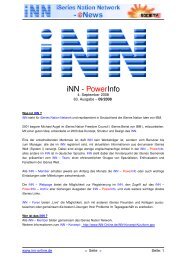Vorwort - SSS-Tools für Power System i Syntax System Services
Vorwort - SSS-Tools für Power System i Syntax System Services
Vorwort - SSS-Tools für Power System i Syntax System Services
Sie wollen auch ein ePaper? Erhöhen Sie die Reichweite Ihrer Titel.
YUMPU macht aus Druck-PDFs automatisch weboptimierte ePaper, die Google liebt.
4.3 A PPP Monitor Utility<br />
By Michael Ryan<br />
<strong>System</strong> i systems have communication capabilities as robust and feature-rich as any computing<br />
system out there. We can communicate via TCP/IP and SNA, sockets or APPC, Ethernet<br />
or dial-up–a host of possibilities. Many of the communication scenarios we employ are TCP/IP<br />
based, whether over a private network or the Internet. Trading partners and financial institutions<br />
often accept VPN connections or SSH connections to transfer data, or require encrypted files<br />
they can then send over a public network such as the Internet.<br />
Dial-up access is another method that’s been around as long as there have been systems<br />
that needed to communicate. Though dial-up was once the only method of communication,<br />
its use has decreased with the advent of the Internet and private networks. However, some<br />
trading partners and financial institutions still require a dial-up connection. One of the most<br />
popular protocols for dial-up is Point-to-Point Protocol (PPP). Another, less popular protocol is<br />
Serial Line Internet Protocol (SLIP), Today, most <strong>System</strong> i dial-up connections that use TCP/IP<br />
applications use PPP.<br />
I won’t cover the configuration of PPP in this article–you can obtain good information about<br />
setup and configuration from IBM’s Information Center. I’ll explain the operation of a program<br />
I developed to programmatically obtain the status of a PPP connection.<br />
Dial Blues<br />
We get used to network communications. Whether across a WAN or a LAN, we’re used to<br />
having the systems and resources available when we want them. We don’t need to establish a<br />
connection to these servers and resources–we just access them (though we may need to login<br />
first).<br />
Alas, not so with dial-up. It’s just not as reliable as WAN or LAN communications. Also,<br />
note that I’m specifically not talking about ISDN or DSL, both of which require a form of<br />
dial-up. I’m talking specifically about PPP–the simple, widely used protocol to connect to a<br />
system. Modems and POTS (plain old telephone system) lines are involved. Ever have a dropped<br />
connection back in the days of dial-up service to AOL or Compuserve? The same issues apply<br />
here. Ever had static on a phone line, whether it was a modem connection or just a voice call?<br />
That’s the unreliability I’m talking about. And I’ve been experiencing that unreliability lately in<br />
a mission-critical application. You know, one of those applications that’s run for years without<br />
a hiccup, and all of a sudden we’re receiving errors that are near-impossible to troubleshoot.<br />
Aging phone lines? Aging modems? Aging communication adapters? Aging programmers?<br />
Whatever the case, we’ve been receiving PPP communication errors too regularly. That’s why I<br />
developed this program.<br />
So, if a PPP connection is inherently unreliable, how do we manage it? First, let’s review how<br />
a connection is established. We use the Start TCP/IP Point-to-Point (STRTCPPTP) command to<br />
www.inn-online.de < Seite > Seite: 57



